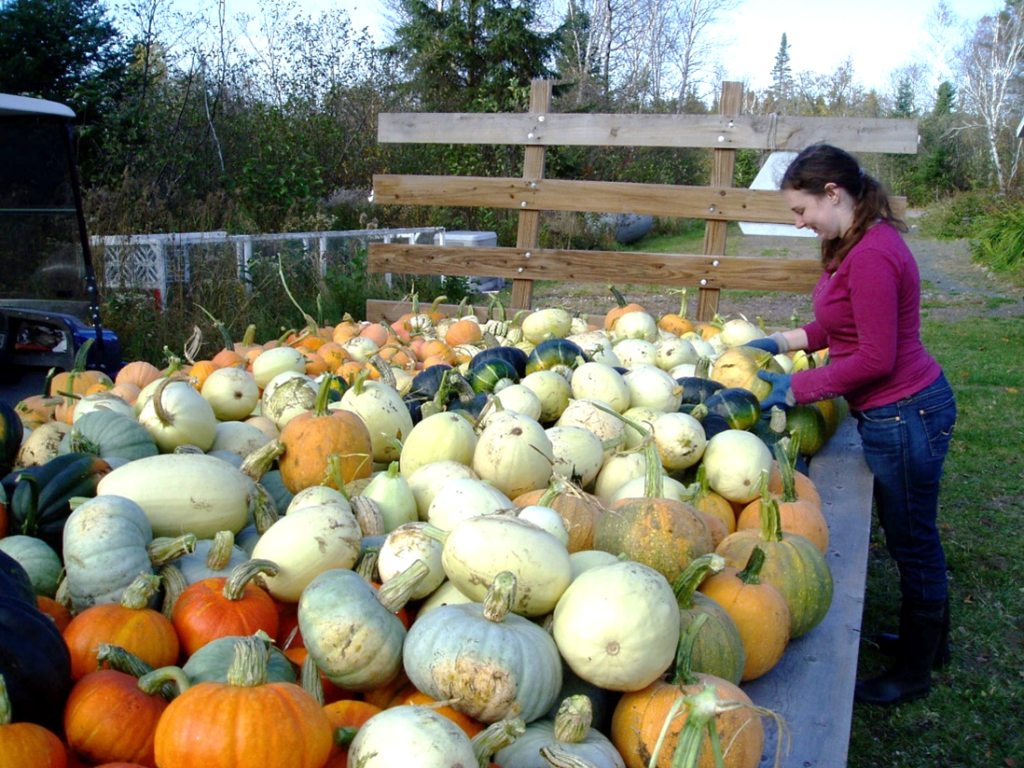Squash-ville

It was a jungle this year. During one of the farm tours, someone observed, “You could hide people in there!”
It grew past the bounds of its freshly-tilled bed. It rose higher than I am tall. It engulfed the fence around the aquaponics greenhouse.
Everyone seemed to be asking, “What is that growing out there?” Vibrant, serrated, deep-green leaves shot upwards, supported by sturdy, prickly stocks. Flowers as large as my outstretched hand shocked the scene with brilliant orangey-yellow.
It was the winter squash.
We’d been wondering what to do with the rest of the old hay field around the sides of the aquaponics greenhouse near Farmstead Creamery. It was too small a piece of ground to hay, too far away from the barn to graze the sheep, and the two celebrity pigs only took up a small portion of the available space. Saplings were springing up and the brambles were encroaching, so it was time to do something with the open land before nature reclaimed it in forest.
So this spring, Kara drove down the skid steer and scraped off the quack grass infested sod and heaped it in a pile in a low spot at the back corner. Then we drove down the summer mobile chicken coops, which had lain fallow all winter, and scooped out all the old, decomposed bedding on top. This delicious (though smelly) layer of nutrients was spread about and then tilled in, allowing for some time to rest and be warmed by the sun before planting.
Squash plants can be such finicky creatures. Start them inside and transplant them, and they go into shock, lying dormant for weeks. Plant them in the ground too early, and they won’t sprout, setting them back as well. We’ve learned to wait—wait for the soil to warm and the nights to shake off their springtime chill—before planting those seeds.
Again with the skid steer, Kara hauled in old round bales of hay, unrolling them to create a carpet of mulch. Then we pushed the mulch aside in little places to make the hills, holding back the fluffy organic matter with our famous “cutworm cups” (made from turning recycled plastic bottles into rings to keep the cutworms from destroying the delicate seedlings).
Mom and I madly planted seeds one day—5 to a hill because it was already nearly July and time would be running out. If the frosts came in late August, as they sometimes do on our farm, at least the plants would be able to set one or two good fruits each before their time was up. And, we theorized, if we were left with a large quantity of unripe squashes, it would make good feed for our Kunekune pigs.
But those squashes had a plan. By four weeks, they had become a solid carpet, three feet tall. By mid-September, they became the towering mass described earlier. And the frosts didn’t come in August. They only barely came once in September, and the squash didn’t seem to be slowed at all.
And then, finally, it frosted Saturday night. The zucchini was toast. The beans were limp. And by mid-day the next morn, there was almost nothing left to be seen of the cucumbers. Those towering winter squashes lay broken, the leaves blackened and brittle, and the stems were bent double, their broken ribs weeping watery sap at the demise of their glory.
It was time for harvest. The beautifully colorful fruits below lay exposed—finally visible after being so hidden in the foliage. They wouldn’t take another frost without serious damage to their skin, reducing the likelihood that they would store well into the winter.
Kara hooked up the trusty hay wagon to the ATV and drove it near the patch. Mom’s cousin Ellen was up for a visit from Seattle, and she and I and our intern Olivia started in on the patch, armed with gloves against the prickers.
Roly-poly pumpkins, warty gourds, shiny kubochas in all sorts of colors, skinny delicottas, little round sweet dumplings, baby pink hubbards, deep green acorns, plump sugar pie pumpkins, football-shaped spaghetti squash… We broke them free of their vines and carried them by the armloads to the hay wagon, sorting them by type. But as the day progressed, the little piles began to merge, heaping into one massive mound.
Back and forth we traipsed, our legs growing weary, our toes catching on the trodden vines, our shirts growing dirty from the slightly-muddy bellies of the squashes and pumpkins. In the end, we drove the golf cart to the far end of the patch, loaded the dump bed full of colorful orbs, then drove it up to the side of the hay wagon for unloading.
Finally, the last spaghetti squash was piled on top. Olivia and I had rubbery arms and legs as we watched Mom and Steve arrive home from running errands. They helped us push the wagon back enough to hook it to the truck and have our grand squash parade all the way to the white-doored shed, where the fruits will be safe from frost until temperatures really plummet.
“I’m squashed!” Olivia sighed, slumping on the seat of the golf cart. It had taken all of the afternoon to pick that patch. Now only the bones of the vines and stems remain—a sorry sight for the once-magnificent village of squash. And of all that haul, only two harvest totes were filled with un-ripened fruits. Those plants really gave it their all this season! I think we’ll be having winter squash for a while… See you down on the farm sometime.





